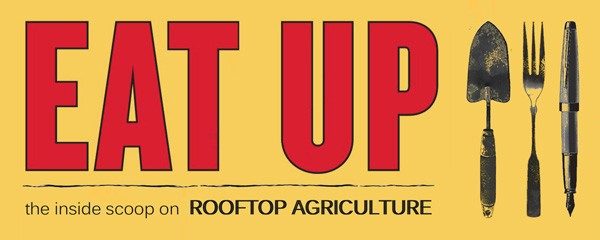fancy plants
Designing and building a rooftop farm may come with a hefty price tag. While many ground-level farms offset costs by expanding acreage, rooftops are limited by the bounds of the building below. So how do you get the most bang for your buck with a slim budget and limited space? Some rooftop growers invest in “fancy plants” to attract business.

Uncommon Ground chef Patch Carroll admires his restaurant’s crops || photo by Lauren Mandel
Heirloom cultivars – diverse crop varieties that became scarce with the onset of industrial agriculture – are re-emerging and gaining momentum in restaurants, farmer’s markets, and backyard gardens around the country. Restaurateurs and foodies alike find the unique flavors of heirloom vegetables irresistible, but many of these crops are difficult to grow, or transport without significant bruising. The solution? Grow them close to the kitchen! There, you can keep a close eye on your babies and eliminate their transportation all together.
In north Chicago’s Edgewater neighborhood, the iconic restaurant Uncommon Ground fully embraces the cultivation of “fancy plants” in it’s 0.06 acre rooftop

Organic rooftop mustard greens || photo by Lauren Mandel
farm. In May I spoke with Dave Snyder, Uncommon Ground’s Rooftop Farm Director from 2008-2012, about his crop selection. Dave explained that he and the head chef work together to select specialty crops that the restaurant can’t source elsewhere. During the 2011 season, Dave grew 37 crop varieties on the roof, some of which were more rare than others. During our interview Dave pined over a rare tomato breed called the Purple Calabash, which he said attracted a lot of attention in the restaurant below. The cultivar bruises like a peach, and so other restaurants decline to carry the magnificent ingredient.
Uncommon Ground capitalizes upon its ability to grow specialty crops that are relatively unattainable by other storefronts. Guests with sophisticated pallets and encyclopaedic plant knowledge may know exactly what’s in each bite. Most guests flock to Uncommon Ground because the food simply tastes too good to be true.

Heirloom tomato at SHARE Food Program || photo by Lauren Mandel
In Vancouver, British Colombia, specialty crops similarly dot the roof of The Fairmont Waterfont hotel. I spoke with executive chef Dana Hauser in August, who rattled off a laundry list of crops grown on the roof for use in the hotel’s kitchens. She mentioned several varieties of heirloom tomatoes, six types of basil, and some unexpected rooftop crops like rhubarb, figs, and goosberries.
It’s safe to say that marketing the uniqueness of your rooftop crops is invaluable. Whether customers come for the superior flavors or for the experience of eating something they can’t get anywhere else, these “fancy plants” create something to brag about.
 EAT UP
EAT UP